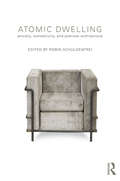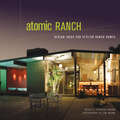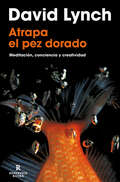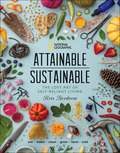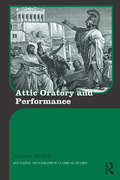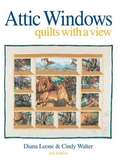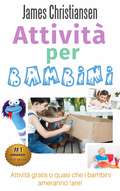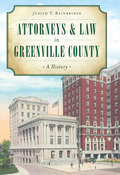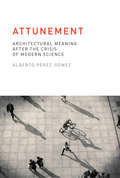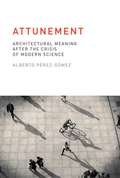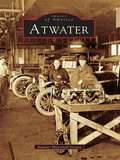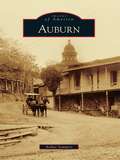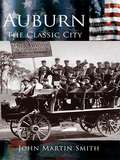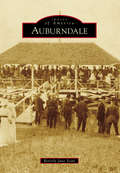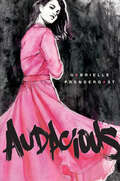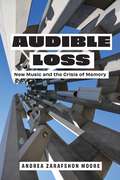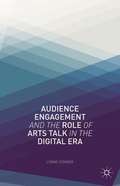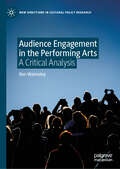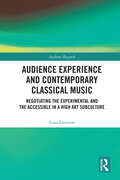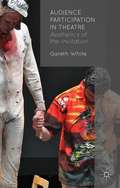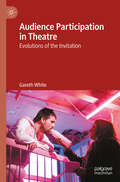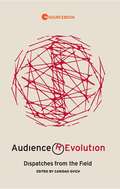- Table View
- List View
Atom Egoyan's 'The Adjuster'
by Tom McsorleyOne of Canada's pre-eminent auteur filmmakers, Atom Egoyan has been celebrated internationally, earning multiple awards from the prestigious Cannes and Toronto Film Festivals and an Academy Award nomination. One of his most accomplished and controversial early works, The Adjuster, is a dark drama about the complex and intense relationship between an insurance adjuster and his clients.In this accessible analysis, Tom McSorley traces the genesis, production, and reception of Egoyan's fourth feature film, from its Cannes Film Festival premiere to its North American commercial release. The book locates The Adjuster in the larger context of Canadian cinema history's peculiar and often troubled evolution, and offers a provocative interpretation of the film's unique analysis of the malaise of materialism in North American culture. Richly illustrated and featuring new interview material with Egoyan himself, this study in the Canadian Cinema series offers an insightful review of one of Atom Egoyan's most searching, unsettling films.
Atomic Dwelling: Anxiety, Domesticity, and Postwar Architecture
by Robin SchuldenfreiIn the years of reconstruction and economic boom that followed the Second World War, the domestic sphere encountered new expectations regarding social behaviour, modes of living, and forms of dwelling. This book brings together an international group of scholars from architecture, design, urban planning, and interior design to reappraise mid-twentieth century modern life, offering a timely reassessment of culture and the economic and political effects on civilian life. This collection contains essays that examine the material of art, objects, and spaces in the context of practices of dwelling over the long span of the postwar period. It asks what role material objects, interior spaces, and architecture played in quelling or fanning the anxieties of modernism’s ordinary denizens, and how this role informs their legacy today.
Atomic Ranch: Design Ideas for Stylish Ranch Homes
by Michelle Gringeri-BrownAn in-depth exploration of midcentury residential architecture in America, with extensive photos and design tips included.Post-World War II ranches (1946–1970) range from the decidedly modern gable-roofed Joseph Eichler tracts in the San Francisco Bay area and butterfly wing houses in Palm Springs, Florida, to the unassuming brick or stucco L-shaped ranches and split-levels so common throughout the United States. In this book Michelle Gringeri-Brown and Jim Brown, founders and publishers of the popular quarterly Atomic Ranch magazine, extol the virtues of the tract, split-level, rambler home and its many unique qualities: private front facades, open floor plans, secluded bedroom wings, walls of glass, and an easy-living style. From updated homes with high-end Italian kitchens, terrazzo floors, and modern furniture to affordable homeowner renovations with eclectic thrift-store furnishings, Atomic Ranch presents twenty-five homes showcasing inspiring examples of stylish living through beautiful color photographs, including before and after shots, design-tip sidebars, and a thorough resource index. Atomic Ranch reveals:Hallmarks of the ranch styleInspiring original ranch homesRanch house transformations and makeoversPreservation of mid-century neighborhoodsAdding personality to a ranch homeYards and landscapingA helpful resource section and index
Atrapa el pez dorado: Meditación, conciencia y creatividad
by David LynchEn Atrapa el pez dorado el director de cine, David Lynch, abre una ventana que nos enseña el panorama de su método creativo como artista; su estilo personal, los beneficios de la creatividad y la práctica de la meditación como eje principal en todas estas actividades. Lynch explora y explica la experiencia de bucear y cazar las ideas como si se tratara de pescar. A continuación nos explica cómo trasladar esta experiencia a la televisión, el cine y otros medios en los que trabaja, como la pintura, la música o el diseño. Lynch narra la experiencia de dedicarse a la meditación durante más de tres décadas (meditación trascendental) y las diferencias que dicha acción ha marcado en su proceso creativo.
Atrapa el pez dorado: Meditación, conciencia y creatividad
by David LynchEn Atrapa el pez dorado el director de cine David Lynch abre una ventana a su mente y nos muestra su particular forma de crear. Atrapa el pez dorado es un ensayo sobre el origen de las ideas y la creatividad que el cineasta americano aplica a su universo personal. El punto de partida del libro es la meditación, algo que le apasiona desde hace años y cuya práctica ha marcado su proceso creativo. Es, también, un compendio de pensamientos que busca fomentar la creatividad y en el que David Lynch aboga por dejar trabajar a la intuición, a la vez que va revelando, de forma ágil y amena, detalles sobre su carrera, sus películas, Hollywood, etc. Música, pintura, películas. Lynch enlaza temas y lanza ideas. Esas ideas que, según él, son como peces persiguiendo el cebo del deseo. Reseñas:«Ideas sobre la meditación al servicio de la creatividad.»Miqui Otero, El País «Atrapa el pez dorado desvela, a su manera, uno de los mecanismos creativos más legendarios del cine moderno: cómo se le ocurren las ideas a David Lynch y cómo logra transformar ideas abstractas en imágenes gracias a la intuición.»Carlos Prieto, El Confidencial
Attainable Sustainable: The Lost Art of Self-Reliant Living
by Kris BordessaPacked with delicious recipes, natural remedies, gardening tips, crafts, and more, this indispensable lifestyle reference from the popular blogger makes earth-friendly living fun.Whether you live in a city, suburb, or the country, this essential guide for the backyard homesteader will help you achieve a homespun life--from starting your own garden and pickling the food you grow to pressing wildflowers, baking sourdough loaves, quilting, raising chickens, and creating your own natural cleaning supplies. In these richly illustrated pages, sustainability-guru Kris Bordessa offers DIY lovers an indispensable home reference for sustainability in the 21st century, with tried-and-true advice, 50 enticing recipes, and step-by-step directions for creating easy, cost-efficient projects that will bring out your inner pioneer. Filled with 340 color photographs, this relatable, comprehensive book contains time honored-wisdom and modern know-how for getting back to basics in a beautiful, accessible package.
Attic Oratory and Performance (Routledge Monographs in Classical Studies)
by Andreas SerafimIn a society where public speech was integral to the decision-making process, and where all affairs pertaining to the community were the subject of democratic debate, the communication between the speaker and his audience in the public forum, whether the law-court or the Assembly, cannot be separated from the notion of performance. Attic Oratory and Performance seeks to make modern Performance Studies productive for, and so make a significant contribution to, the understanding of Greek oratory. Although quite a lot of ink has been spilt over the performance dimension of oratory, the focus of nearly all of the scholarship in this area has been relatively narrow, understanding performance as only encompassing 'delivery' – the use of gestures and vocal ploys – and the convergences and divergences between oratory and theatre. Serafim seeks to move beyond this relatively narrow focus to offer a holistic perspective on performance and oratory. Using examples from selected forensic speeches, in particular four interconnected speeches by Aeschines (2, 3) and Demosthenes (18, 19), he argues that oratorical performance encompassed subtle communication between the speaker and the audience beyond mere delivery, and that the surviving texts offer numerous glimpses of the performative dimension of these speeches, and their links to contemporary theatre.
Attic Windows Quilts with a View: 2nd Edition
by Cindy Walter Diana LeoneAttic Windows is a timeless technique that allows quilters of all skill levels to use their creativity and favorite motif fabrics. This volume contains a gallery of more than 50 inspiring quilts, information on selecting fabrics, tips on how to use colors effectively, numerous exercises to help the quilter plan a one-of-a-kind quilt, and step-by-step instructions for one project.
Attività per bambini: Attività gratis o quasi che i bambini ameranno fare!
by James ChristiansenDescrizione libro: Bambini, vi lamentate che “non c’è niente da fare” oppure “Mi annoio”? Avete bisogno di nuove idee per tenere occupati i vostri figli finché ricomincia la scuola o anche solo per questo pomeriggio? Non muovetevi - questa guida di attività gratuite o a buon mercato vi aiuterà a scacciare la tristezza della noia! Probabilmente i miei bambini sono come i vostri: Amano stare a casa da scuola ma presto o tardi il suono dei “Mi annoio” e “non ho niente da fare” riecheggia per tutta la nostra casa e sia io che mia moglie bramiamo avere qualcosa con cui tenerli impegnati per evitare di sentire i loro piagnistei. Con questo obiettivo ho radunato queste attività gratis o a buon mercato che i miei figli amano e che ameranno anche i vostri! In questo libro imparerete: 1.Come intrattenere i bambini in età prescolare e come farlo a buon mercato! 2.Divertire con attività in casa e all’aperto per bambini dai 6 agli 8 anni 3.Come far divertire i più grandi già indipendenti con un budget ristretto 4.Divertimento in casa e all’aperto per tutte le età 5.Attività divertenti con l’aggiunta di insegnar loro qualcosa di buono per bambini di tutte le età Avete bisogno di qualcos’altro per acquistare questo libro? Eccone subito un’altra: dono il 5% dei ricavi dalle vendite dei miei libri alla “Leggere è Fondamentale”, la più grande e rispettata associazione americana di letteratura no-profit per bambini Basta con le lamentele e cura oggi la noia. Acquista questo libro e sbizzarrisciti oggi stesso con grandi idee per intrattenere i bambini!
Attorneys & Law in Greenville County: A History
by Judith T. BainbridgeFor more than two hundred years, lawyers and judges, many of them colorful and powerful personalities, have practiced law and maintained order in Greenville County. In the nineteenth century, Judges Richard Gantt and Waddy Thompson began the tradition of Upstate justice. At the time of the Civil War, Benjamin Perry and his colleagues argued fiercely about secession. Recently, local attorneys and judges, both black and white, have struggled with integration and civil rights issues. History is dotted with legal dynasties; individual practioners like "Miss Jim" Perry and John Bolt Culbertson; and judges, including J. Robert Martin and Frank Eppes, who have played significant roles in Upstate law. Author Judith Bainbridge details the impact and personalities of law and lawyers in Greenville County.
Attunement: Architectural Meaning after the Crisis of Modern Science
by Alberto Perez-GomezHow architecture can move beyond the contemporary enthusiasms for the technically sustainable and the formally dazzling to enhance our human values and capacities. Architecture remains in crisis, its social relevance lost between the two poles of formal innovation and technical sustainability. In Attunement, Alberto Pérez-Gómez calls for an architecture that can enhance our human values and capacities, an architecture that is connected—attuned—to its location and its inhabitants. Architecture, Pérez-Gómez explains, operates as a communicative setting for societies; its beauty and its meaning lie in its connection to human health and self-understanding.Our physical places are of utmost importance for our well-being. Drawing on recent work in embodied cognition, Pérez-Gómez argues that the environment, including the built environment, matters not only as a material ecology but because it is nothing less than a constituent part of our consciousness. To be fully self-aware, we need an external environment replete with meanings and emotions.Pérez-Gómez views architecture through the lens of mood and atmosphere, linking these ideas to the key German concept of Stimmung—attunement—and its roots in Pythagorean harmony and Vitruvian temperance or proportion. He considers the primacy of place over space; the linguistic aspect of architecture—the voices of architecture and the voice of the architect; architecture as a multisensory (not pictorial) experience, with Piranesi, Ledoux, and Hejduk as examples of metaphorical modeling; and how Stimmung might be put to work today to realize the contemporary possibilities of attunement.
Attunement: Architectural Meaning after the Crisis of Modern Science
by Alberto Pérez-GómezArchitecture remains in crisis, its social relevance lost between the two poles of formal innovation and technical sustainability. In Attunement, Alberto Pérez-Gómez calls for an architecture that can enhance our human values and capacities, an architecture that is connected -- attuned -- to its location and its inhabitants. Architecture, Pérez-Gómez explains, operates as a communicative setting for societies; its beauty and its meaning lie in its connection to human health and self-understanding.Our physical places are of utmost importance for our well-being. Drawing on recent work in embodied cognition, Pérez-Gómez argues that the environment, including the built environment, matters not only as a material ecology but because it is nothing less than a constituent part of our consciousness. To be fully self-aware, we need an external environment replete with meanings and emotions.Pérez-Gómez views architecture through the lens of mood and atmosphere, linking these ideas to the key German concept of Stimmung -- attunement -- and its roots in Pythagorean harmony and Vitruvian temperance or proportion. He considers the primacy of place over space; the linguistic aspect of architecture -- the voices of architecture and the voice of the architect; architecture as a multisensory (not pictorial) experience, with Piranesi, Ledoux, and Hejduk as examples of metaphorical modeling; and how Stimmung might be put to work today to realize the contemporary possibilities of attunement.
Atwater
by Atwater Historical SocietyThe town of Atwater was rich in a different kind of treasure than the gold usually sought by people flocking to California in the 1850s. Named for Marshall D. Atwater, a tenant on several of founder John W. Mitchell's 2,000-acre parcels, the community boasted a mineral-rich alluvial soil that made it an extremely productive agricultural area. When the Central Pacific Railroad came through--thanks to lobbying from Mitchell, along with several strips of free land deeded to the railroad--a switch was laid next to Atwater's warehouse. The train switch and the building became known as Atwater Station, and in time, the town itself bore his name.
Auburn
by Art SommersAuburn, the county seat of Placer County, was founded during the Gold Rush in 1848. Unlike many such towns in the Mother Lode, Auburn has remained a vibrant and growing town ever since. This city's relevance since the initial influx of gold seekers is due in part to its location at a nexus of transportation routes, both old and new. Halfway between San Francisco and Reno and at an elevation of just over 1,000 feet--above the fog and below the snow--Auburn is a very attractive place to live. Furthermore, it is a place with sincere respect for its roots, as evidenced by its restored old town, preserved courthouse building, and other historic structures throughout town.
Auburn Correctional Facility
by Michael Pettigrass Eileen Mchugh Cayuga MuseumWhat is now called Auburn Correctional Facility has been open in Auburn since 1817, and it is the oldest continually operating prison in the country. Auburn's claim to being the preeminent American prison is bolstered by its many firsts. Auburn was the first prison in the world to house convicts in individual cells and the first prison in the country to employ a chaplain and put a matron in charge of the women prisoners. Auburn Prison developed the widely duplicated system of inmate management that became known as the Auburn System, a totally silent regimen of forced labor and complete control. Auburn was the first prison to separate mentally unstable inmates from the general population and was the site of the world's first use of the electric chair for capital punishment. The prison was at the front line of the prison reform movement in the early 20th century when Thomas Mott Osborne was voluntarily incarcerated and helped found the Mutual Welfare League in Auburn Prison in 1913.
Auburn: The Classic City
by John Martin SmithThe citizens of Auburn, Indiana ensure that their city is truly special among the 22 Auburns in the United States. From the time of foraging hogs and cows roaming its streets to nude swimming at the YMCA pool, the landscape of this small town is ever changing and often surprising. Auburn's past is full of many exceptional instances of residents fighting against injustice, including hosting stops along the Underground Railroad and raising Company K of the 44th Indiana Volunteer Infantry to serve the Union during the Civil War. Even before Auburn became a city in 1900, her devoted people displayed how difficulties can be turned into opportunities, and they have always risen to the challenge.Auburn: The Classic City reveals these stories and much more about this big-impact city with the small-town feel. Once called "Little Detroit," Auburn featured prominently in the automobile era, producing 24 different makes of cars before 1937, a heritage now preserved in its world-class museums. This lush transportation history also earned the town the name "Home of the Classics." Featured here are highlights from this time as well as such tales as the raid on the police department by John Dillinger's gang. Readers journey alongside the persistent people who transformed this community into the DeKalb County seat where the tree-lined streets, historic residences, and beautiful city parks belie the city's illustrious tradition of industry and innovation. In Auburn: The Classic City, more than 100 never-before-published photographs accompany the artful narrative.
Auburndale
by Beverly June ScottAuburndale was carved out of the central Florida wilderness in 1884 when the South Florida Railroad selected the location to build a depot. Surrounded by clear, sand-bottomed lakes, the site was located almost equally between the ocean and gulf and was 14 miles from Bartow, the county seat. The new depot was named after Auburndale, Massachusetts, which was the hometown of one of the owners. When completed, the depot was the only building in sight. Settlers quickly realized the advantage of being close to the railroad, and by 1889 Auburndale had 30 homes and a population of 270. One church, seven stores, a livery stable, two hotels, and a sawmill lined the sandy streets. The young community survived fires that destroyed Main Street twice, a tornado that demolished their schools, and devastating freezes that killed citrus trees.
Audacious (Young Adult Novels)
by Gabrielle PrendergastSixteen-year-old Raphaelle says the wrong thing, antagonizes the wrong people and has the wrong attitude. She can't do anything right except draw, but she draws the wrong pictures. When her father moves the family to a small prairie city, Raphaelle wants to make a new start. Reborn as "Ella," she tries to fit in at her new school. She's drawn to Samir, a Muslim boy in her art class, and expresses her confused feelings in explicit art. When a classmate texts a photo of Ella's art to a younger friend, the fallout spreads throughout Ella's life, threatening to destroy her already-fragile family. Told entirely in verse, Audacious is a brave, funny and hard-hitting portrait of a girl who embodies the word audacity.
Audible Loss: New Music and the Crisis of Memory
by Andrea Zarafshon MooreAn innovative and much-needed critical work on music and memorialization in relation to AIDS, 9/11, and anti-Black violence in AmericaMusic has long served as a powerful medium for communal mourning and remembrance in times of crisis. Audible Loss examines musical responses to three major crises in US society at the turn of the twenty-first century: the AIDS epidemic, the terrorist attacks of September 11, 2001, and the ongoing conditions of anti-Black violence.Analyzing a range of works written to commemorate these losses, Andrea Zarafshon Moore explores how contemporary classical music (aka “new music”) frames and narrates these crises, gives voice to grief, imagines other possibilities, and makes loss audible. These crises are read alongside one another to reveal the ways they are mutually imbricated, while also recognizing the sheer commemorative dominance of 9/11 in this century. Attending to broader debates and discourses through which commemoration is always filtered and the ways interpretive consensus has been sought and articulated in both musical and other memorial forms, Moore probes the conventional claims of commemoration, particularly those for the necessity of remembrance to “healing” and the prevention of future crises.Audible Loss concludes by reflecting on the limits of existing commemorative forms and the possibility, even necessity, of new ones. Taking the COVID-19 pandemic as a case study, it proposes that while memorials of all kinds may provide outlets for collective remembrance and even mourning, their power to forge a sense of collectivity is diminished as public discourse grows more fragmented. Deeply informed yet highly approachable, Audible Loss is a major contribution to the fields of music and memory studies and essential reading for anyone interested in memory culture in the United States today.
Audience Engagement And The Role Of Arts Talk In The Digital Era
by Lynne ConnerThis book offers readers an understanding of the theoretical framework for the concept of Arts Talk, provides historical background and a review of current thinking about the interpretive process, and, most importantly, provides ideas and insights into building audience-centered and audience-powered conversations about the arts.
Audience Engagement in the Performing Arts: A Critical Analysis (New Directions in Cultural Policy Research)
by Ben WalmsleyThis book explores the concept of audience engagement from a number of complementary perspectives, including cultural value, arts marketing, co-creation and digital engagement. It offers a critical review of the existing literature on audience research and engagement, and provides an overview of established and emerging methodologies deployed to undertake research with audiences. The book focusses on the performing arts, but draws from a rich diversity of academic fields to make the case for a radically interdisciplinary approach to audience research. The book’s underlying thesis is that at the heart of audience research there is a mutual exchange of value wherein audiences ideally play the role of strategic partners in the mission fulfilment of arts organisations. Illustrating how audiences have traditionally been side-lined, homogenised and vilified, it contends that the future paradigm of audience studies should be based on an engagement model, wherein audiences take their rightful place as subjects rather than objects of empirical research.
Audience Experience and Contemporary Classical Music: Negotiating the Experimental and the Accessible in a High Art Subculture (Audience Research)
by Gina EmersonThis book responds to recent debates on cultural participation and the relevance of music composed today with the first large-scale audience experience study on contemporary classical music. Through analysing how existing audience members experience live contemporary classical music, this book seeks to make data-informed contributions to future discussions on audience diversity and accessibility. The author takes a multidimensional view of audience experience, looking at how sociodemographic factors and the frames of social context and concert format shape aesthetic responses and experiences in the concert hall. The book presents quantitative and qualitative audience data collected at twelve concerts in ten different European countries, analysing general trends alongside case studies. It also offers the first large-scale comparisons between the concert experiences and tastes of contemporary classical and classical music audiences. Contemporary classical music is critically discussed as a ‘high art subculture’ rife with contradictions and conflicts around its cultural value. This book sheds light on how audiences negotiate the tensions between experimentalism and accessibility that currently define this genre. It provides insights relevant to academics from audience research in the performing arts and from musicology, as well as to institutions, practitioners and artists.
Audience Participation in Theatre
by Gareth WhiteThis book asks that we consider the practices that facilitate audience participation on equal terms with other elements of the theatre maker's art; it offers a theoretical basis for this new approach, illustrated by examples from diverse participatory performances.
Audience Participation in Theatre: Evolutions of the Invitation
by Gareth WhiteThis new textbook edition of Audience Participation in Theatre: Evolutions of the Invitation situates the text in evolving theory, emerging practice, and changing contexts, re-establishing itself as the key reference point in its field. An updated review of the literature and a new chapter develops its original argument with respect to historical change in how audiences and their expectations are constituted, and changes to how participation is invited, mediated and valued.
Audience Revolution: Dispatches from the Field
by Caridad Svich Alison Carey Bill RauchA collection of thoughtful and provocative reflections on how theatre practitioners think about and engage with audiences, as well as define and explore sites for performance. Through shared experience and ritual, live performance functions as a catalytic medium for progress and evolution. In the hands of artists and audience, the stage is set for the re-makings of commonwealth, or necessary revolution.Caridad Svich received a 2012 OBIE Award for Lifetime Achievement in the theater, a 2012 Edgerton Foundation New Play Award for GUAPA, and the 2011 American Theatre Critics Association Primus Prize for her play The House of the Spirits, based on the Isabel Allende novel.

